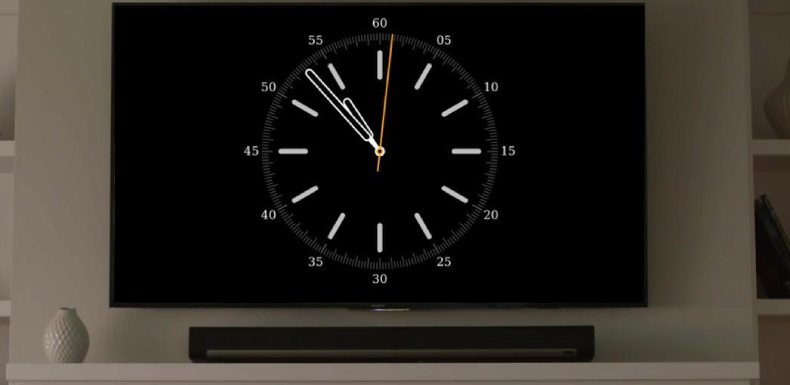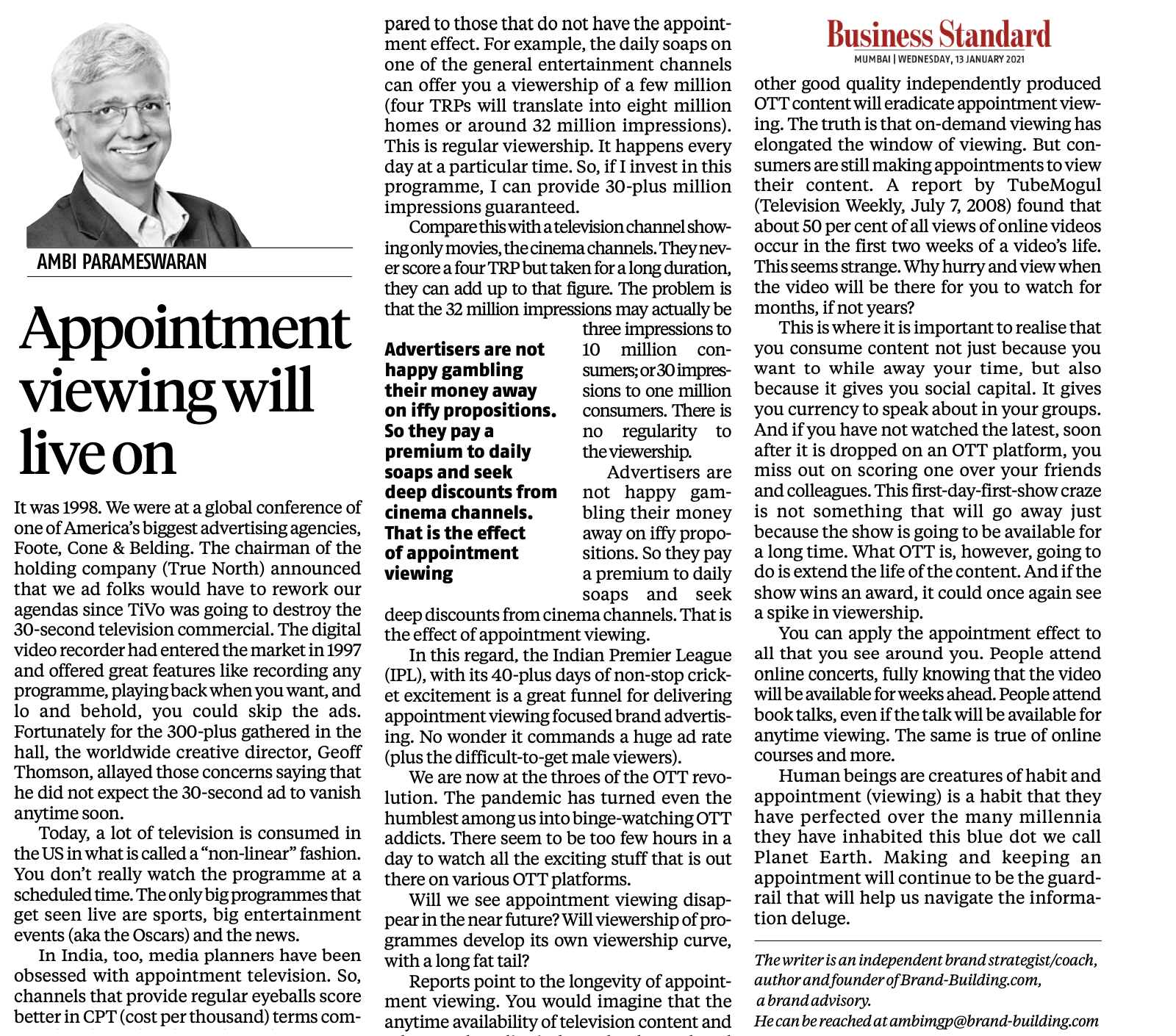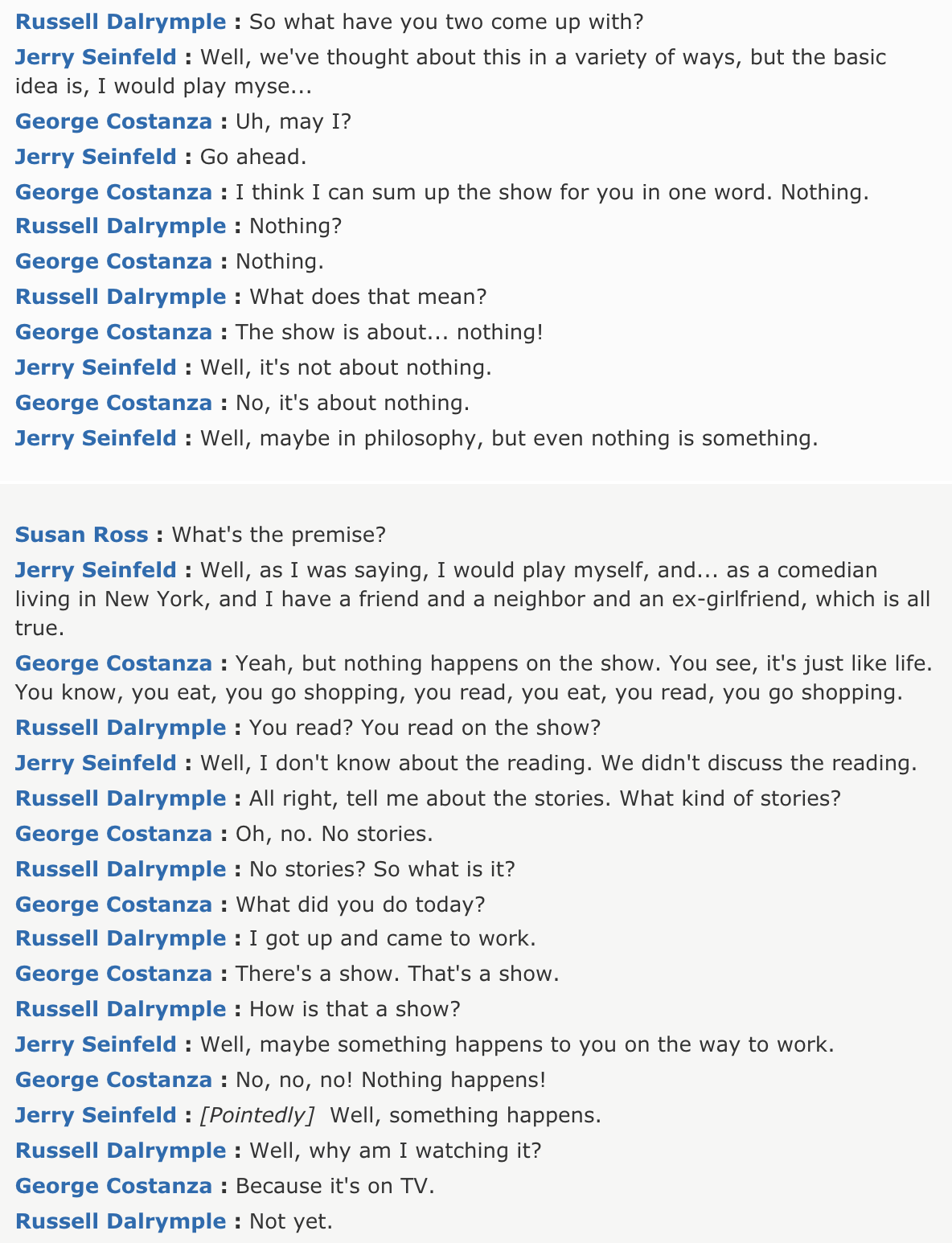
This is a follow-up to/continuation of Ambi Parameswaran’s recent Business Standard write-up.

Appointment viewing, by definition, is “setting time aside to watch particular television programs”.
If I move it beyond TV, it would be “appointment-based content consumption”. A good example is the habit of reading the newspaper in the morning. Do we read the newspaper in the morning because it would be entertaining or interesting? Hardly. We read it in the morning because it arrives in the morning, and if we read it in the afternoon or evening, it’d be old news already.
Back in the Doordarshan era, we sat in front of the TV at 9 pm for Prime Time news. We waited for The World This Week on Friday 10 pm. We waited for a specific time for Hum Log, Buniyaad, Khandaan, Yeh Jo Hai Zindagi etc.
If we do not make time for them, they would be gone – forever.
So, appointment viewing in the pre-OTT period was driven by scarcity.
This scarcity was, at that time, driven by the limitations of technology.
Books
But, take the example of books in that period (pre-OTT). New books were released. But were they also purchased at the same period as they were released? The bestseller lists in magazines told a different story – ‘new’ books were in the bestseller list for a long time – Dale Carnegie’s How To Win Friends and Influence People has been on such lists for decades.
Why? There was no scarcity of availability in that content (books). If the first print run is sold out, they print it again (depending on demand forecasts). So there was no pressing reason to be the first one to buy the book – it was always going to be available.
Movies in theaters
A parallel example is movies released in theaters. That has the scarcity window too – a movie is available for a limited period driven by audiences’ demand. You need to watch it in that period of availability. If you miss it, it is gone forever.
However, unlike a TV program, the lifespan of availability for a theatrically released film is as long as there is a demand for it. And like books, some movies were re-released too, based on demand.
But the streaming/OTT technology changed all this forever. Now, content (books in ebook format, digital music, digital video) is available forever – there is no availability window, no scarcity based on time.
So what happens to appointment viewing/consumption of content when there is no availability window?
Consider what happens when a new TV series ‘drops’ on OTT (all episodes at once). People obviously do not need to watch it as soon as it drops – there is no time-bound compulsion that they should. Yet, many people do! People watch it as early as possible, which is still not the simultaneous viewing that non-OTT TV made possible via technological limitations (lack of non-linear content access).
Even when the TV series has weekly episodic drops (one episode a week), you still do not need to catch up as soon as it drops, or even the same day/week! Yet, many people do! Not at the same time, but in the same period which is much longer than linear TV’s simultaneous viewing.
Why?
Because of 3 reasons.
1. FOMO – Fear of missing out:
If you don’t watch it, but your immediate social circle has, you may not be able to take part in the discussion. FOMO is a well-established phenomenon that makes people do things that they may not have otherwise consider doing, including really dangerous acts like taking selfies in really life-threatening circumstances and locations.
2. Bragging rights:
A variation of FOMO. If FOMO was about not wanting to miss out on something, this is inclusive – wanting to be the first (among the first) ones to see something as a signal to your social circles. This is competing to become an opinion maker, by catching up on content the fastest. Most professional reviewers of content do this for a living, without this bragging angle involved.
3. Marketing:
I’d argue that this is THE most important consideration why content that is available any time with no restriction on the lifespan is viewed/consumed closer to the launch date. The content owners’ marketing efforts are at the highest and most vocal/high decibel closer to the launch date. This is simply common sense: you advertise something the most when it is new.
But ‘new’ in the case of OTT is just a word. For instance, if a well-known series like Friends or Seinfeld is added afresh to an OTT platform (because they purchased the rights only then), there would be a surfeit of viewing for that content closer to that date of addition.
In terms of marketing, unlike the linear TV era, on OTT it is done not to accumulate viewers because the content will vanish soon, but to merely inform that such content is now available. So, awareness would be at the highest during the marketing period. Interestingly, even when a platform drops one episode a week (as against the Netflix-style approach of dropping all episodes at once), each episode’s drop works as a marketing effort for the entire series. For Netflix, their marketing is done once when the whole show drops – episodic drops help extend the marketing period longer, thereby keeping the interest in the content alive for a longer time, relatively.
This is also the reason why earlier seasons of existing TV shows gain a fresh set of viewers when a new season drops – the marketing for the new season gets the earlier season in front of people who may not have seen it at all.
So, much like the Stories feature on Snapchat, Instagram, Facebook, and now LinkedIn, even when there is no need for appointment viewing on OTT platforms, marketing creates an artificial reason to simulate appointment viewing.
In any case, on a subscription-based service (most OTT platforms), the highest number of viewers is not the only goal – it’s a good-to-have goal, but not the only one, as in the case of linear TV. The goal would rather be to let existing subscribers feel that they have done the right thing by subscribing and to gain new subscribers as a result of the lure of the new content.
Outside of OTT platforms and linear TV, many things come back into circulation long after they first made their appearance. For instance, Sea Shanty, a genre of songs traditionally sung by sailors laboring on ships, is making a massive comeback. Similarly, several classic songs from another era make a stupendous come-back when they are reused in a new piece of content. For example, The Spinners’ 1976 song Rubberband Man got a new lease of life when it was re-marketed (used in) via Avengers: Infinity War.
Where appointment viewing rules
Live content is the last bastion of appointment viewing. Not impromptu live content (news that breaks), but pre-planned live events like sports, award ceremonies, important political speeches/occasions (swearing-in ceremonies), etc. But, to be fair, live events are appointment-based participation – there is a window of opportunity to participate in something happening then and there, and hence, much like the linear TV broadcast. If you miss it, the charm of catching it live is gone forever.
You could obviously watch the recorded version of these live events later, but for the same reasons like FOMO and bragging rights, chances are you may watch it live if you can adjust your time/calendar/day around it.
Bottom-line: Appointment viewing is dead.
If it survives, it is only because it is artificially simulated as a necessity by the content owners. And, unlike linear content, you have the complete freedom to ignore the temptations of marketing and consume it when YOU want to.
By and large, you do not plan your time/calendar/day around any content anymore because you do not need to. You don’t need to build or stick to a habit of catching up with predictable pieces of content in your day. When YOU want it, the content will manifest itself in front of you because technology has made it possible. In other words, the content would adjust itself to suit your day, as you want it.
As linear TV is standing on its last legs, supported by countries that cannot move whole swathes of the population to the streaming bandwagon, we may be in the last stages of appointment viewing too.
The idea, and the concept, of appointment viewing, is dead.
Nothing explains how outmoded appointment viewing is better than the Seinfeld episode The Pitch! In the episode, a cocky George and Seinfeld are pitching for a show where nothing happens. The only thing given is their confidence that people are already waiting because it is on TV. Why? Read on 🙂

Cover picture courtesy: APKpure
